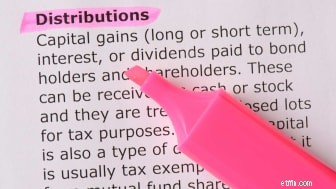
할 일 목록에 있는 항목:포트폴리오를 정리하고 자선 단체에 기부하여 2019년 세금 고지서를 정리하십시오. 은퇴 계획 기여도를 높이십시오. 신용 카드 보상으로 현금. 또한 2020년 및 그 이후에 수익을 높일 수 있는 움직임을 제안합니다. 살펴보세요.

과세 대상 계정(IRA와 같은 세금 이연 계정이 아님)에서 승자를 판매하는 경우 양도소득세 청구서가 발행됩니다. 그러나 지불한 가격에서 떨어진 주식이나 뮤추얼 펀드를 매각하고 손실을 다른 투자의 이익을 상쇄하는 데 사용할 수 있습니다.
단기 손실을 단기 이익과 정렬하고, 장기 손실과 이익도 동일하게 하십시오. 손실이 이익을 초과하는 경우 최대 $3,000의 손실을 사용하여 일반 소득을 상쇄할 수 있습니다. 이를 초과하는 손실은 향후 연도로 이월될 수 있습니다(연 최대 $3,000).

과세 대상 계정에 대한 뮤추얼 펀드를 쇼핑하는 경우 구매하기 전에 펀드 웹사이트를 확인하십시오. 그렇지 않으면 투자로 인해 막대한 세금이 부과될 수 있습니다.
12월 한 달 동안 많은 펀드가 한 해 동안 축적된 배당금과 자본 이득을 지불합니다. 배당락일이라고 알려진 날에 주식을 소유하고 있다면 돈을 재투자하더라도 배당금에 대해 세금을 내야 합니다.
펀드에 투자하기 전에 펀드사에 전화를 하거나 홈페이지에서 연말정산일과 예상금액을 확인한다. 추정치는 종종 펀드의 현재 주가에 대한 백분율로 보고됩니다. 주가의 2%에서 3%의 분배는 아마도 세금 문제를 많이 일으키지 않을 것입니다. 그러나 펀드가 주가의 20%에서 30%를 지불할 것으로 예상한다면 분배가 끝날 때까지 기다렸다가 매수하십시오. —또는 다른 펀드에 투자하는 것을 고려하십시오.

2017년 세금 개편은 전반적으로 세율을 낮추었지만 일부 인기 있는 세금 혜택도 폐지했습니다. 그 결과 환급을 받는 데 익숙해져 있던 일부 납세자가 2018년 세금 보고서를 제출할 때 IRS에 빚을 지게 되었습니다.
당신이 불만을 품은 납세자들의 일원이었다면 지금과 연말 사이에 조치를 취하여 4월의 또 다른 놀라움을 피할 수 있을 것입니다. IRS 세금 원천 징수 추정기 도구를 사용하여 고용주에게 새로운 양식 W-4를 제출하고 지금과 연말 사이에 급여에서 원천 징수된 세금 금액을 늘려야 하는지 여부를 결정하십시오. 2019년 소득을 추정하는 데 도움이 되도록 가장 최근 급여 명세서와 2018년 세금 보고서 사본이 필요합니다. 지금과 연말 사이에 몇 개의 급여 기간만 남아 있기 때문에 청구하는 수당의 수를 줄이면 원천 징수액의 차이가 세금 청구서에 영향을 미칠 만큼 충분하지 않을 수 있습니다. 대신 W-4 양식의 6행으로 이동하여 원천징수할 금액을 기입하십시오.

재정이 크게 바뀌지 않는 한 2019년 세금 보고서를 제출할 때 항목별로 분류할지 표준 공제를 청구할지 꽤 잘 알고 있을 것입니다. 항목별로 분류할 계획이라면(또는 임계값에 근접한 경우) 지금이 1월에 납부해야 하는 모기지 상환금 및 주세와 같은 공제 가능한 비용을 선불로 지불하기에 좋은 시기입니다.

2019년에는 조정 총소득의 10%를 초과하는 미지급 의료비만 공제할 수 있습니다(2018년 기준은 7.5%). 이로 인해 대부분의 납세자들이 이 세금 혜택을 누릴 수 없습니다. 그러나 예를 들어, 중대한 질병으로 인해 올해 매우 높은 의료비를 지출했다면 자격이 될 수 있습니다.
그리고 공제액을 증가시킬 약속과 절차를 예약할 시간이 아직 있습니다. 적격 비용 목록에는 귀하의 보험이 적용되지 않을 수 있는 치과 및 안과 진료가 포함됩니다. 전체 개요는 IRS 간행물 502, 의료 및 치과 비용을 참조하십시오. .

대학생의 부모(또는 조부모)인 경우 다음 학기 등록금을 선불로 납부하여 2019년 세금 고지서를 낮출 수 있으며 이 세금 감면을 청구하기 위해 항목화할 필요가 없습니다. 학부 과정의 첫 4년 동안 받을 수 있는 American Opportunity Tax Credit은 자격을 갖춘 학생당 최대 $2,500의 가치가 있습니다. 수정 조정 총 소득이 최대 $160,000인 부부가 공동으로 신고하는 경우 전체 공제를 청구할 수 있습니다. 최대 $180,000의 MAGI를 가진 사람들은 일부 금액을 청구할 수 있습니다.
마찬가지로, 내년에 자신의 경력을 쌓기 위해 수업을 들을 계획이라면 12월 31일 이전에 1월 청구서를 선납하여 2019년 세금 보고 시 평생 학습 크레딧을 청구할 수 있도록 하십시오. 크레딧은 최대 $2,000까지 수업료, 수수료 및 책에 대한 본인 부담 비용의 최대 20%에 해당합니다. 학부 비용에만 국한되지 않으며 풀 타임 학생 일 필요도 없습니다. 결혼한 부부가 최대 $114,000까지 MAGI에 공동으로 제출하면 전체 크레딧을 청구할 수 있습니다. 최대 $134,000의 MAGI를 가진 사람들은 부분 크레딧을 청구할 수 있습니다.

연말 전에 529에 돈을 넣어두어도 연방 세금이 줄어들지는 않지만 주 세금 탭이 낮아질 수 있습니다. 30개 이상의 주에서 주 소득세에서 529개 플랜 기부금의 최소 일부를 공제할 수 있습니다. 대부분의 주에서 세금 공제를 받으려면 해당 주의 계획에 기여해야 하지만 일부 주에서는 모든 주의 계획에 대한 기부금 공제를 허용합니다. www.savingforcollege.com에서 해당 주의 규칙을 확인하십시오. 많은 주에서 조부모와 다른 사람들이 자녀의 계획에 기부할 수 있도록 허용하고 일부 주에서는 이러한 기부금 공제도 허용합니다.

귀하 또는 귀하의 가족 중 특별한 도움이 필요한 사람이 있는 경우 올해 최대 $15,000를 ABLE 계정에 기부할 수 있습니다. 이를 통해 자격을 갖춘 장애가 있는 사람들은 정부 혜택을 위태롭게 하지 않고 돈을 절약할 수 있습니다. 자신의 주의 계획에 투자할 필요는 없지만 ABLE 계정에 대해 세금 혜택을 제공하는 10개 주 중 하나의 거주자인 경우 기여금을 공제할 수 있습니다. 자세한 내용은 장애인에게 더 많은 재정적 자유를 제공하는 ABLE 계정을 참조하십시오.

2019년에는 연방 증여세 신고 없이 최대 $15,000까지 원하는 만큼 많은 사람에게 기부할 수 있습니다. 귀하의 선물이 한도 미만인 한, 연방 유산세 면제에 영향을 미치지 않습니다.
면제 금액은 현재 1,140만 달러(결혼한 부부의 경우 2,280만 달러)이지만 상속세에 대해 걱정할 필요가 전혀 없을 것이라고 가정하지 마십시오. 현재 면제는 2026년에 약 550만 달러로 되돌아갈 예정이며(의회에서 인상하지 않는 한), 이는 연방 유산세가 적용되는 유산의 수를 크게 증가시킬 것입니다. 위스콘신주 라신에 있는 Johnson Financial Group의 수석 자산 관리자인 Joe Maier는 정치적 상황에 따라 면제가 그보다 더 빨리 취소될 수 있다고 말했습니다. 350만 달러.
지금 돈을 기부하면 귀하의 유산이 주 유산이나 상속세의 영향을 받을 가능성도 줄어듭니다. 12개 주와 컬럼비아 특별구는 자체 유산세를 부과하며 일부는 엉클 샘보다 훨씬 낮은 기준을 적용합니다. 또한 6개 주에는 상속세가 있으며 메릴랜드에는 둘 다 있습니다.

많은 자선단체가 이 시기에 연간 기부금의 대부분을 받습니다. 이는 사람들이 자신의 행운을 공유하기를 원하기 때문만은 아닙니다. 과거에는 많은 사람들이 연말이 되기 전에 선행을 해서 세금보고 시 공과금을 내기 위해 기부했습니다. 그러나 새로운 세법은 표준 공제액을 거의 두 배로 늘려 항목별 납세자의 비율을 약 30%에서 10%로 줄였습니다.
2018년 세금 보고서를 제출했으므로 2019년에 항목별로 분류할지 아니면 표준 공제를 청구하는 대다수의 납세자에 합류할지 여부에 대해 꽤 좋은 아이디어를 얻었을 것입니다. 하지만 여유가 있다면 자선 기부의 타이밍을 맞추면 세금을 줄일 수 있습니다. 즉, 중요한 대의를 지원하는 데 더 많은 돈을 쓸 수 있습니다.
작동 방식은 다음과 같습니다. 매년 같은 금액을 자선 단체에 기부하는 대신 몇 년 동안의 기부금을 한 해에 합산하여 항목별로 다른 공제 가능한 비용과 함께 충분한 공제를 받을 수 있습니다. 쉬는 기간에는 표준 공제를 청구하십시오.
쉬는 기간 동안 좋아하는 자선단체를 계속 지원하려면 기부자 조언 기금에 일시금을 기부하는 것을 고려하십시오. 이 기금을 사용하면 1년 안에 많은 공제액을 기부할 수 있으며 나중에 돈을 어떻게 사용할지 결정할 수 있습니다. 대부분의 금융 서비스 회사는 기부자 조언 기금을 제공합니다. Fidelity Charitable 및 Schwab Charitable의 최소 투자 금액은 $5,000입니다.
현금 외에도 대부분의 대규모 기부자 조언 펀드는 평가 유가 증권의 기부를 수락하며 주식 시장의 장기 상승 후에는 특히 세금에 정통한 전략이 될 수 있습니다. 1년 이상 유가증권을 보유하고 있다면 유가증권을 기부할 때 해당 유가증권의 공정 시장 가치를 공제할 수 있습니다. 자본 이득에 대해 세금을 내지 않아도 되며 자선 단체에서도 세금을 내지 않아도 됩니다.

70.5세 이상이고 기존 IRA에 필요한 것보다 더 많은 돈이 있는 경우, 적격 자선 분배라는 도구를 활용하여 좋아하는 자선 단체를 돕고 세금을 낮출 수 있습니다.
QCD를 사용하면 IRA에서 최대 $100,000까지 자선단체에 직접 기부할 수 있습니다. 이전은 필요한 최소 분배에 포함됩니다. 기여금은 공제할 수 없지만 조정 총소득에는 포함되지 않습니다.
AGI를 낮추면 Medicare 파트 B와 D에 대한 고소득 할증료를 피하는 데 도움이 될 수 있으며 세금이 부과되는 사회 보장 혜택의 비율도 줄일 수 있습니다. 이 방학을 이용하려면 기부금이 IRA에서 직접 돕고자 하는 자선 단체로 전달되어야 합니다. 수표가 12월 31일까지 자선 단체에서 현금화될 수 있도록 연말 전에 송금하십시오.

2019년에는 401(k), 403(b), 연방 저축 저축 계획 또는 기타 고용주가 제공하는 퇴직 계획에 최대 $19,000를 보관할 수 있으며 50세 이상인 경우 캐치업 기여금으로 $6,000를 적립할 수 있습니다.
장기적으로 퇴직연금 기여금을 늘리면 퇴직금이 부족해질 위험이 줄어들지만 단기적 혜택도 있습니다. 전통적인 401(k)에 대한 기부는 세전이므로 12월 31일 이전에 양말을 많이 벗을수록 4월 15일에 IRS에 납부해야 하는 세금이 줄어듭니다.
급여를 얼마나 자주 받느냐에 따라 연말 전에 급여에서 원천징수한 금액을 늘릴 수 있는 충분한 시간이 있을 수 있습니다. 연말 보너스를 받는 경우 퇴직 저축 계획에 기여할 수 있는지 고용주에게 문의하십시오.
H&R Block의 Tax Institute의 수석 세금 리서치 애널리스트인 Nathan Rigney는 세금 유예 퇴직 계획에 기여하면 조정된 총 소득이 줄어들어 세금 청구서를 줄이는 데 도움이 될 수 있다고 말합니다. 또한 AGI가 특정 임계값을 초과하면 수많은 세금 감면이 단계적으로 중단되거나 사라집니다.
직장에 은퇴 계획이 없으면 IRA에 최대 $6,000, 50세 이상인 경우 $7,000까지 공제할 수 있습니다. 직장 퇴직 계획의 적용을 받는 독신 납세자는 소득이 $64,000 미만인 경우 기존 IRA 기여금을 공제할 수 있으며 소득이 $74,000에 도달할 때까지 금액이 점차적으로 감소합니다. 부부가 공동으로 신고하는 경우 IRA 기부를 하는 배우자가 직장 퇴직 계획의 적용을 받는 경우 소득 단계적 축소는 $103,000 ~ $123,000입니다. 2020년 4월 15일까지 2019년 IRA에 기부해야 하지만 지금 그 돈을 투자하면 저축을 늘릴 수 있는 시간이 훨씬 더 많아집니다.
고용주가 Roth 401(k)를 제공하는 경우 기여금은 2019년 세금 청구서를 낮추지 않지만 은퇴할 때 면세 인출을 할 수 있습니다. 전통적인 Roth IRA와 달리 Roth 401(k) 플랜에는 소득 제한이 없습니다. 일반 401(k)와 Roth 401(k) 간에 기부금을 나눌 수 있지만 합산 기부금은 $19,000 또는 50세 이상인 경우 $25,000를 초과할 수 없습니다.

고용주가 급여에서 자동으로 돈을 공제하고 기여금과 일치시키면 저축하는 것이 훨씬 쉽습니다. 그러나 스스로 일을 하는 사람들은 비록 시간제일지라도 잠옷을 입고 일할 수 없는 친구들보다 세금을 줄이고 훨씬 더 많은 돈을 절약할 수 있습니다.
2019년에는 자영업 또는 프리랜스 소득이 있는 모든 사람이 사용할 수 있는 솔로 401(k) 계획에 최대 $56,000(50세 이상인 경우 $62,000)까지 기부할 수 있습니다. 귀하의 기여금은 해당 연도의 자영업 소득을 초과할 수 없습니다. 2020년 4월 15일까지 솔로 401(k)에 기부하고 2019년 기부금을 공제해야 하지만 12월 31일까지 열어야 합니다.
또 다른 옵션은 SEP IRA이지만 보조 공연에서 약간의 추가 수입이 있다면 솔로 401(k)에서 더 많이 저축할 수 있습니다. SEP 기부금은 자영업 소득의 20%, 최대 $56,000로 제한됩니다.

70½ 이상이고 IRA 또는 기타 세금 이연 계좌(예:전 고용주의 401(k) 플랜)에 돈이 있는 경우 필요한 최소 분배금은 필수입니다. 12월 31일까지 RMD를 복용하지 않으면 복용해야 하는 금액에 대해 50%의 벌금이 부과될 수 있습니다.
RMD는 전년도 12월 31일 현재 계정 잔액을 연령에 따른 기대 수명 계수로 나눈 값을 기반으로 합니다(RMD 축소 방법 참조). 올해 70.5세가 되면 2020년 4월 1일까지 첫 번째 RMD를 받아야 하지만 그 때까지 기다리면 내년에 두 개의 RMD를 받아야 하므로 더 높은 세율을 적용받을 수 있습니다.
할 일 목록에서 이 항목을 선택하기 위해 올해의 마지막 주까지 기다리지 마십시오. 연말까지 귀하의 계좌에 현금이 입금될 수 있도록 금융 기관이 거래를 처리할 수 있는 충분한 시간을 주어야 합니다.

건강 관리 유연한 지출 계정이 있는 경우 잔액과 규칙을 검토하십시오. 일부 계정은 여전히 연말에 남은 금액을 몰수하도록 요구하지만 대부분은 최대 $500까지 이월하도록 허용하거나 전년도 비용 청구에 대한 유예 기간을 제공합니다. If you’re running out of time to use the cash, start by reimbursing yourself for eligible expenses that you didn’t claim earlier in the year.
You can use the money to pay for out-of-pocket medical expenses, including deductibles and co-payments, as well as uncovered dental and vision expenses. Beyond that, stock up on FSA-eligible products that you’ll use in the coming year, such as contact lens solution, first aid items and hearing aid batteries. For a list of eligible items, go to FSAStore.com.

The holidays may take a bite out of your budget, but they’re also a good time to find savings. In December stores and restaurants offer enticing bonuses on gift cards, says Julie Ramhold, consumer analyst with DealNews.com. You might, for example, purchase a certain amount and get additional gift cards free. December is also a prime month to buy jewelry, at 40% to 70% off.
If you have a big-ticket item in mind, take advantage of Black Friday and Cyber Monday sales. “Almost every category you can think of will have something on sale,” says Ramhold, with deals abounding in clothing, shoes, electronics and home goods. Discounts on laptops often exceed back-to-school markdowns, and TV sets may come with discounts and generous gift cards.
Could your toaster or blender use an upgrade? Around Black Friday, department stores sell small kitchen appliances at the deepest discounts you’ll find all year.

Looking for extra money to travel or shop during the holiday season? Take stock of rewards points, miles or cash back that you’ve accumulated with credit cards as well as hotel, airline and retail loyalty programs. Credit cards typically provide cash back as a statement credit, bank account deposit or check. You may be able to exchange points or miles for gift cards, retail purchases (say, using them directly at Amazon.com) or travel bookings.

Now is a good time to pick up a credit card with a generous initial bonus of cash back or points. One of our favorites, Chase Sapphire Preferred Visa ($95 annual fee), hands out 60,000 points if you spend $4,000 in the first three months of card membership. The bonus is worth $750 in travel redemptions through Chase.
Also consider Capital One Venture Visa ($95, waived the first year), with a 50,000-mile bonus worth $500 in travel statement credits for spending $3,000 in the first three months. If you’re loyal to an airline or hotel chain, check out its credit card. The Marriott Bonvoy Boundless Visa ($95) recently served up 100,000 bonus points, worth roughly $800, for spending $5,000 in the first three months.

Now is the time to calculate how many paid vacation days you have left in 2019 that won’t roll over to 2020. The U.S. Travel Association reports that 55% of Americans didn’t use all their paid time off in 2018, compared with 52% in 2017. The average number of unused days in 2018 was 6.5, up from six in 2017.
For less-expensive flights, concentrate your search over the first two weeks of December. Kayak found that median round-trip airfares hover around $245 for the first and second weekends of December, but jump by more than $100 for travel the weekend before Christmas.
For some high-end hotel deals throughout most of December—and excellent value year-round—consider Mexico. Gabe Saglie, of deal-finding site Travelzoo, recommends the five-star Andaz Mayakoba resort in Playa del Carmen, which recently offered a three-night stay starting at $495, plus 20% off dining and a $75 spa credit, for select dates through December 23.
To catch the beginnings of summer in Australia before the crowds arrive around Christmas, head Down Under in late November or early December. For example, ADGE Apartments in Sydney, an apartment-style hotel with units that sleep up to four guests, recently offered nightly rates starting at $143 for the first three weeks of December on Travelzoo.

Airline or hotel elite status, especially at the higher tiers, comes with a host of valuable perks, from complimentary upgrades on flights to free breakfast spreads and late checkouts at hotels. But the major U.S. hotel chains and airlines require you to requalify each calendar year in order to enjoy elite status for the rest of that year and the next calendar year. If you’re on the cusp of eligibility for a tier, then scheduling a “mileage run” to rack up the flights you need for your preferred airline, or a “mattress run” to get the overnight stays you need for your hotel loyalty program, may be worth the hassle and the cost.
Hotel loyalty programs are usually straightforward:Your tier depends on how many nights you stay. “The price of the room doesn’t matter,” says Scott Mayerowitz, executive editorial director of ThePointsGuy.com. “The hotel just wants to know that your head has hit the bed.” Marriott, for example, starts increasing its basic member benefits once you stay for 10 or more nights. Some hotel credit cards give you a handful of elite night credits or award you status outright.
Airlines are trickier. With American Airlines, Delta and United, you need to fly a certain number of miles or “segments” (each portion of your itinerary that requires a takeoff and landing), as well as spend a minimum amount on airfare, excluding taxes and fees, to ascend the tiers. (United recently announced changes to its program starting in the 2020 qualification year.) For example, the lowest American Airlines elite tier requires a minimum spend of $3,000 in “elite qualifying dollars,” as well as 25,000 “elite qualifying miles” or 30 “elite qualifying segments.” Those thresholds jump to $15,000, 100,000 miles and 120 segments for the highest level. Mayerowitz says that most travelers qualify by miles rather than segments.
Before turning a nonstop flight into a three-city hop to bulk up on segments or spending a couple of nights at a hotel, look at the benefits of whatever tier you’re chasing, especially if an airline or hotel co-branded credit card gets you similar perks or a fast-track to elite status.

The end of the year is the ideal time to thank those who made your life easier—and a tip or gift is a nice way to do it. Tally a list of people who provide service to you on a regular basis, such as your mail carrier, cleaner or caregiver for a loved one (leave professionals who don’t rely on or expect a gratuity, such as your financial adviser or doctor, off the list). Prioritize your tips based on your relationship and the frequency and quality of the service. Allow yourself enough time to stock up on fresh bills, gift cards or knickknacks that will show your appreciation—and to hand over your gratuities in person or by mail (see 16 People You Should Tip for the Holidays).
You may need to dig a little to figure out the “rules” for tipping certain workers. For example, U.S. Postal Service carriers are prohibited from accepting cash, checks or gift cards that can be used like credit cards, but a gift worth up to $20 is allowed. Day-care centers, schools, caregiving agencies and nursing homes may also have rules governing monetary tips, in which case home-baked treats, group gifts or thank-you notes may be more appropriate.
If you employ a senior-care aide directly, consider tipping at least a week’s pay; the same goes for a regular child-care provider. For a housekeeper or cleaner, the cost of one visit is appropriate. That’s also true for your hairstylist, unless you tip well all year.

Now is a good time to ask yourself how you’d be affected by a major stock market decline. First, consider your risk capacity—how a portfolio slide would affect your financial picture, such as your ability to retire on time or make scheduled withdrawals from retirement accounts that have sunk in value. Then consider your risk tolerance—how such a downturn would affect you psychologically. Someone 30 years from retirement has the capacity to take on riskier investments, says Sam Huszczo, a certified financial planner in Southfield, Mich. But if that person is likely to panic and sell investments when markets get volatile, “it may be prudent to take the risk down a notch,” he says.
If you couldn’t handle, say, a 33% dip in stocks (the average loss in Standard &Poor’s 500-stock index during bear markets since World War II), consider replacing some of your stocks with investments designed to mitigate risk. One option:a balanced fund, which comes with a built-in allocation to bonds (which are less volatile than stocks). 뱅가드 웰링턴 (symbol VWELX), a member of the Kiplinger 25, invests some 65% of assets in stocks and 35% in bonds. (The fund is open to new investors if purchased directly through Vanguard.) The fund’s annualized return beat 94% of peer funds over the past 15 years, and it charges just 0.25% in annual expenses. (All prices and returns are as of September 30.)
Want to stick with stocks but reduce some turbulence? Try a low-volatility exchange-traded fund. Consider two exchange-traded funds in the Kiplinger ETF 20. IShares Edge MSCI Min Vol USA ETF (USMV, $64), with a 0.15% expense ratio, zeroes in on stocks of steadier large and midsize U.S. companies. Small-company stock investors can try Invesco S&P Smallcap Low Volatility ETF (XSLV, $49), charging 0.25%.
If you aren’t making big changes, at least rebalance your portfolio to make sure your holdings are in line with your long-term plan. “This is not an environment in which you want to get over your skis” in any stock, sector or asset class, says Liz Ann Sonders, Schwab’s chief investment strategist. Selling some of your highest flyers builds defense into your portfolio. Tech stocks have been bull-market leaders, but if history is any guide, they may lead the decline, too. “Cutting back on tech could cushion you on the downside,” says Lewis Altfest, of Altfest Personal Wealth Management.

A good way to put new cash to work is in undervalued or out-of-favor parts of the market. Consider dollar-cost averaging—investing a fixed amount on a regular schedule—into shares of large, value-priced companies, small-company stocks or beaten-down sectors such as energy and health care. Energy Select Sector SPDR (XLE, $59, expense ratio 0.13%) focuses on U.S. energy firms. IShares Global Energy (IXC, $31, 0.46%) covers the world. For health care, we like Invesco S&P Equal Weight Health Care (RYH, $196, 0.40%).
International stocks have lagged U.S. shares in recent years, but looking ahead, David Kelly, JPMorgan chief global strategist, is optimistic about international stocks. Vanguard Total International Stock Index (VTIAX, 0.11%), or its cheaper ETF version (VXUS, $52, 0.09%), invests in developed and emerging markets. For actively managed funds, we favor Fidelity International Growth (FIGFX, 0.95%) and Oakmark International (OAKIX, 0.96%).

A letter to Santa shouldn’t be the only wish list investors make this December. After a record-long run, some of the hottest stocks of the bull market are now pricey. But if there are stocks you’d like to own that are too high-priced for now, take note and watch closely. When the market pulls back and prices come down, you’ll be ready to pounce. Here are a few names we’re keeping an eye on.
Global property-and-casualty insurer Chubb Ltd. (CB, $161) is among the highest-quality companies in its industry, says Fidelity Equity-Income manager Ramona Persaud. The superlative “is not really subjective,” Persaud says, because it’s borne out by the firm’s consistent underwriting and robust returns on capital. After a 27% run-up so far this year, the shares trade at a pricey premium to book value (an important valuation measure for financial firms and insurers) relative to their history. Chubb’s return potential in any market environment is bolstered by its dividend, which the firm has boosted annually for 26 years straight.
Shares of data analytics firm Verisk (VRSK, $158), which provides risk-management analysis to professionals in the insurance, financial and energy industries, have returned 45.7% in 2019 and trade at 34 times year-ahead earnings, compared with a price-earnings ratio of 17 for the S&P 500. With a whopping 80% of sales coming from long-term subscriptions, Verisk boasts consistent recurring revenues and robust pricing power. New ways of gathering data, such as through artificial intelligence and machine learning, are making Verisk’s business more efficient, says Parnassus Core Equity fund manager Todd Ahlsten. He says the market for risk analytics will likely grow over time and expects the firm to boost earnings at about a 10% annual clip over the next decade.

If you haven’t reviewed your credit reports lately, head to www.annualcreditreport.com, where you can get a free report from each major credit bureau—Equifax, Experian and TransUnion—every 12 months. Look for suspicious changes, such as a credit card account or mailing address that you don’t recognize, which could mean you’ve been the victim of ID theft. If you find a problem, take steps to clear it (see Battle the Credit Bureaus ... and Win).
Already claimed your annual reports? Take advantage of other ways to view your reports for free. By creating an account at https://my.equifax.com, you can access an Equifax report and VantageScore credit score monthly. With Experian’s www.freecreditscore.com, you can see your Experian credit report and FICO score monthly. And TransUnion’s www.trueidentity.com allows you to pull up an updated TransUnion credit report daily.

Freezing your credit reports blocks lenders from viewing them in response to a request for new credit in your name. When you’re ready to apply for credit, you can temporarily lift the freeze. Both placing and removing a freeze are free. For a step-by-step guide, read Freeze Your Credit in 3 Steps.
The Experian and TransUnion services offer free monitoring and alerts of significant changes on your credit reports. Or, if you were a victim of the 2017 Equifax data breach, you have until January 22 to claim at least four years of free monitoring of your reports from all three bureaus; go to www.equifaxbreachsettlement.com. Another option:At CreditKarma.com, get free monitoring of your Equifax and TransUnion reports (viewing your reports and VantageScores from those bureaus is free, too).

Holiday get-togethers can be good times to lay the groundwork for future family money conversations. Start by identifying the key people who should know about your plans and which aspects are most important for others to know, says Betsy Simmons Hannibal, a lawyer who writes about estate planning for Nolo.com. Talking to your family about how you plan to divvy up property and other assets can head off sibling squabbles and uncertainty (see 10 Ways to Talk to Your Aging Parents About Their Finances).
Even if you prefer not to provide specifics, it’s important for your heirs to understand the basics of how they’ll receive any inheritance, along with the reasoning behind your decision. You might, for example, explain that you plan to divide assets unequally among your children because one has a lower earning potential due to a health condition, say, or one has made a financial sacrifice to help you in retirement.
As you review your decisions, make sure your will and beneficiaries listed on financial accounts are up-to-date. You should also broach the subject of what you’ll likely expect from your family as you get older. Let your adult children (or others who will be involved in your care) know if you have a long-term-care insurance policy or if you will be relying on other resources or family assistance to cover costs as you age.
To head off any legal or financial problems if an illness or accident occurs, make sure your family knows where you keep estate-planning documents, including a will, powers of attorney for finances and health care, and any health care directives. Check in with anyone you’ve named as an executor or health care proxy to make sure they’re aware of the responsibility and your wishes.
If you’re having this discussion with your adult children, ask about their plans as well. Pertinent questions include whether they’ve drafted a will or made updates since having children, and whether they have enough life insurance and long-term-disability insurance.